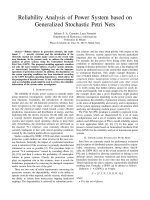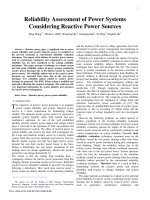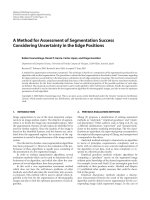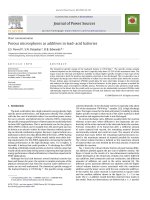Reliability assessment of power systems considering reactive power sources
Bạn đang xem bản rút gọn của tài liệu. Xem và tải ngay bản đầy đủ của tài liệu tại đây (1.61 MB, 7 trang )
1
Abstract— Reactive power plays a significant rule in power
system reliability and security. Reactive power is considered as
the network constraint in conventional reliability evaluation
techniques. The impact of the failures of reactive power sources
such as synchronous condensers and compensators on system
reliability has not been considered in the existing reliability
techniques. This paper presents a technique to evaluate system
and load point reliability indices of power systems considering
reactive power shortages due to the failures caused by reactive
power sources. The reliability indices due to the reactive power
shortages are separated from those due to the real power
shortages. Two reliability indices related to reactive power
shortage are proposed. The IEEE 30-bus system is modified and
analyzed to illustrate the proposed technique. The results provide
very important information for system planners and operators
for reactive power management.
Index Terms— Reactive power, power system reliability.
I. I
NTRODUCTION
he objective of reactive power provision is to maintain
power system reliability and security. Reactive power
reserve is a basic requirement for maintaining voltage
stability. The adequate reactive power reserve is expected to
maintain system integrity under both normal and post
contingency operation. As one of the well established
ancillary services, reactive power support and voltage control
plays a vital role in the operation of both conventional and
restructured power systems. The effect of reactive power on
system stability and security has been well investigated [1]-
[8]. Large area blackout usually occurs in a heavily loaded
system which does not have adequate local reactive reserves.
Heavily loaded systems not only have high reactive power
demand but also high reactive power losses in the lines.
During a disturbance, the real power component of line
loadings does not change significantly, whereas the reactive
power flow can change dramatically [1].
The reason is that the voltage drop resulting from a
contingency reduces the reactive power generation from line
charging, thereby increasing reactive power losses. Sufficient
reactive reserves should be available to meet the Var changes
following a disturbance. How much more reactive power a
power system can deliver depends on the operating condition
The authors are with the School of EEE, Nanyang Technological
University
1
, Singapore (e-mail: ) and Power Engineering
School, Taiyuan university of Technology
2
, China
and the location of the reserves. Many approaches have been
developed in reactive power management and monitoring in
order to improve the reliability of the system with respect to
voltage stability/security problems [1]-[8].
Therefore it is important to consider the impact of reactive
power in power system reliability evaluation in order to obtain
more accurate reliability indices. Reliability evaluation
techniques have been well developed [9]-[12]. The reactive
power is usually considered as the network constraints in
those techniques. During post contingency load shedding, the
network violation is alleviated through the proportional or
priority load shedding without considering the rule of reactive
power. The estimation of post-contingency voltages and
reactive power generation and flows was discussed using
sensitivities [13]. Though employing piecewise linear
estimates, the effect of equipment limits on the estimates was
captured. The effect of shunt capacitor on distribution system
reliability was studied [14]. The composite system reliability
was investigated from the standpoint of voltage limits and
generator real/reactive power constraints in [15]. The
expected value of curtailed kWh due to lack of reactive power
generation or due to exceeding of voltage limits and the
expected value of voltage irregularity were also investigated
[15].
However the following problems are either ignored or
seldom considered in the existing reliability evaluation
techniques. Firstly most existing techniques for power system
reliability evaluation ignored the impact of the failures of
reactive power resources such as synchronous condensers and
various compensators on system reliability. Secondly most
reliability evaluation techniques concerned more on the
problems caused by real power shortage rather than those
caused by reactive power unbalance during post contingency
load shedding. Thirdly, the reliability indices due to the
reactive power shortage were seldom considered separately
with those due to the real power losses. System operators
could not find the information related to the reliability
problems caused by reactive power shortage from the existing
reliability indices provided by the conventional reliability
evaluation techniques. Therefore
there is a need to find a
relationship between the reactive power and system
reliability with respect to voltage violations and system
reliability.
This paper presents a technique to evaluate system and load
point reliability of a power system considering reactive power
shortage due to failures caused by reactive power sources
such as generators, synchronous condensers and
Reliability Assessment of Power Systems
Considering Reactive Power Sources
Peng Wang
1,2
, Member, IEEE, Wenping Qin
2
, Xiaoqing Han
2
, Yi Ding
1
, Xinghui Du
2
T
978-1-4244-4241-6/09/$25.00 ©2009 IEEE
2
compensators. The reliability indices due to the reactive
power shortages are separated from those due to the real
power losses. The reliability indices related to reactive power
shortages are proposed to provide more information to system
operators and planners. The IEEE test system is modified and
analyzed to illustrate the proposed technique.
Section II discusses the important characteristics of reactive
power sources and load. The real and reactive power models
of generator, transmission line, compensator and load are also
presented. The reliability evaluation techniques and load
shedding methods will be discussed and the reliability indices
associated with Var shortage during the post contingency are
proposed in Section III. The modified IEEE 30-bus system
has been analyzed using the proposed techniques and the
results are presented in IV. Section V concludes the paper.
II. R
EACTIVE
P
OWER
C
HARICTERISTICS
A
ND
M
ODELING
There are three aspects that differentiate reactive power
from active power in power system operation. Firstly, it is not
efficient to transfer reactive power over a long distance
because the reactive power loss in transmission system is
significant. Reactive power losses are typically about ten
times of the active power losses due to the inductive nature of
transmission lines. Therefore it is better to compensate the
reactive power locally. Secondly, the main role of reactive
power is to maintain voltage stability/security of power
systems. The effect of reactive power on system reliability in
terms of energy not supplied is indirect and should be
calculated based on reactive power shortage and voltage
violation. Thirdly, the total reactive power loss in the
transmission network often exceeds the total reactive power
load. The reactive power loss changes with system
configuration and operation condition [7]-[8]. Reactive power
requirement for releasing voltage violation after a contingency
are heavily dependent on reactive power reserve distributions
in the system. In order to determine and re-dispatch real and
reactive power reserve for post contingency restoration, the
models of various real and reactive power sources have to be
studied.
A. Generator
A generator can provide both capacitive and inductive
reactive power. According to a NERC planning standard
guideline [4], reactive capability within 0.9 lagging and 0.95
leading should be available. A physical constraint in Var
provision by a generator is its generation capability constraint
which represents the hard physical limitation of a generator's
capability for the simultaneous production of real and reactive
power. A typical generation capability curve is shown in Fig.
1.
The real power output of a generator is usually limited to a
value within the MVA rating by the capability of its prime
mover [16]. When real power and terminal voltage of a
generator is fixed, the armature and field winding heating
limits restrict its reactive power output. The armature heating
limit is a circle with radius
at
IVR =
1
centered on the origin
C
1
(0, 0) and given by the following equation:
2
at
22
)IV(QP ≤+
(1)
Fig. 1 Typical generation PQ curves
The field heating limit follows a circle with radius
d
it
2
X
EV
R =
,
centered at
⎟
⎟
⎠
⎞
⎜
⎜
⎝
⎛
−
d
2
t
2
X
V
,0C
and given by Equation 2.
2
d
it
2
d
2
t
2
X
EV
X
V
QP
⎟
⎟
⎠
⎞
⎜
⎜
⎝
⎛
≤
⎟
⎟
⎠
⎞
⎜
⎜
⎝
⎛
++
(2)
where V
t
is the voltage magnitude at the generator bus, I
a
is
the steady state armature current, E
i
is the excitation voltage
magnitude, X
d
is the synchronous reactance, P and Q are real
and reactive power output, respectively. The machine rating
S
R
is the intersection point of the two circles. The
corresponding rated real power output is denoted by P
R
. The
reactive power capability limits of generator can be
determined by:
()
d
2
t
2
2
d
it
max
X
V
P
X
EV
PQ −−
⎟
⎟
⎠
⎞
⎜
⎜
⎝
⎛
≤
for P<P
R
(3)
()
22
atmaxg
P)IV(PQ −≤
for P>P
R
(4)
In real time operation, actual reactive power reserve Q
r
from a generator can be determined using the capability
curves as
()
currentmaxr
QPQQ −=
(5)
where Q
current
is the reactive power dispatched in the normal
operation.
In most conventional reliability techniques, constant
maximum and minimum reactive power limits Q
max
and Q
min
are used in AC power flow analysis. The reactive power
model for synchronous condenser is similar to generator. In
this paper the maximum reactive power provided by a
generator is assumed to be Q
R
when the real power output is
P
R.
3
B. Transmission line
An equivalent
π
model is used to represent a long line in
Fig. 2.
Y
’
/2
Z
’
I
s
I
r
V
s
V
r
Y
’
/2
+
+
-
-
Fig. 2. Equivalent
π
model of a transmission line.
The real and reactive power losses along a transmission line
depend on line parameters such as series impedance Z
’
, and
parallel admittance Y’, and bus voltages at the sending and
receiving ends [16]. The equations to calculate the real and
reactive power losses for short, medium and long lines can be
found in [16]. Heavily loaded transmission lines lead to large
inductive reactive power losses. In this case generators and
compensators need to produce sufficient reactive capability to
maintain the reactive power balance and to keep voltages
within the specified limits.
C. Var Compensators
Compensation devices can provide both capacitive and
inductive reactive power for a power system. A reactive
power compensator is usually connected between a bus and
ground. There are static and dynamic Var compensators in
power systems. A basic dynamic Var generation arrangement
using a fixed capacitor with a thyristor-controlled inductor is
shown in Fig.3. The constant capacitive Var generation Q
C
of
the fixed capacitor is opposite to the variable Var absorption
Q
L
(
γ
) of the thyristor-controlled inductor to yield the total
variable Var output Q
T
(
γ
) =Q
L
(
γ
)-Q
c
. For a specific voltage V,
the required positive or negative Q
T
(
γ
) can be obtained by
changing turn off angle
γ
of thysistor. It is assumed Var
compensators can provide both capacitive and inductive
reactive power.
Fig.3. A typical thyristor-controlled Var compensator and its Q output
D. Load
Load at a bus of a bulk power system is the aggregation of
the associated sub-transmission network and various loads.
Therefore modeling such an aggregate load requires the
network parameters of sub-transmission system and the
profile of each individual load. A typical PV curve is shown in
Fig. 4 which addresses the proper voltage profile at a load bus
in a power system [17]. It can be seen from the curve that bus
voltage is reduced as load increases. The real P
b
and reactive
Q
b
power at point b correspond to values at the low limit of
the bus voltage. c is the point of system voltage collapse when
the reactive power provided by system is less than the
required reactive power Q
c
to maintain voltage level at V
c
. The
reactive safety margin can be defined using the curve as:
bcurrentr
QQQ −=
(6)
Fig.4. A typical PV curve at a load bus
III. R
ELIABILITY
I
NDICES AND
E
VALUATION
T
ECHNIQUE
A. Component reliability models
A power system component such as generator,
synchronized condenser, transmission line and reactive device
can be represented using the two-state reliability model [18]
as shown in Fig. 5. The availability A and unavailability U can
be calculated based on failure rate and repair rate using the
following equations.
Up
λ
Down
μ
Fig. 5 Two-state model of a component
A
μλ
μ
+
=
(7)
U
μλ
λ
+
=
(8)
B. Basic system reliability indices
Considering an N-component power system, the basic
reliability parameters such as the probability
i
p
, departure
rate
i
λ
, frequency F
i
, the total real power generation capacity
P
i
and reactive power generation capacity Q
i
for state i with M
failed components can be determined using the following
equations respectively:
∏∏
=+=
=
M
1j
j
N
1Mj
ji
UAp
(9)
∑∑
+=
+==
N
Mj
M
j
jji
11
μλλ
(10)
V
+
I
L
SW
I
c
I
Q
L
C
Q
L
(
γ
)
Q
T
(
γ
)
Q
c
γ
Q
V
P(Q)
O
a
b
c
P
b
(Q
b
)
P
current
(Q
current
)
P
c
(Q
c
)
4
iii
PF
λ
=
(11)
∑
=
=
Ngi
1k
ki
PP
(12)
∑
=
=
Nqi
1k
ki
(13)
where A
j
, U
j
,
j
λ
and
j
μ
are the availability, the unavailability,
the failure rate and the repair rate of component j respectively,
P
k
is the available real power capacity of generator k, Q
k
is
reactive power capacity of compensator or generator k, and
N
gi
is the total number of generators and N
qi
is the total
number reactive power sources.
C. Load point and system reliability indices
Two conventional annualized reliability indices of the
expected load curtailment (ELC) and the expected energy not
supplied (EENS) can be calculated using the proposed
technique. The EENS due to the real power shortage (EENS
P
)
and reactive power shortage (EENS
Q
) are separately
calculated. The expected MVarh shortage (EVarS)
considering the failures of reactive power sources and the
expected Var not supplied EVNS are defined to provide more
reliability information for system planners and operators. The
annualized reliability indices for annual constant load can be
calculated using the following equations:
∑
=
×=
NC
1i
ii
FLCELC
(14)
∑
=
××=
NC
1i
iPiP
8760pLCEENS
(15)
∑
=
××=
NC
1i
iQiQ
8760pLCEENS
(16)
∑
=
××=
NC
1i
iQiQ
8760pQCEVNS
(17)
8760pVarSEVarS
NC
1i
iQi
××=
∑
=
(18)
where NC is the total number of considered contingencies,
Pi
LC
and
Qi
LC
are the real power load curtailment due to real
power and reactive power shortage for state i respectively,
Qi
QC
are the reactive power load curtailment due to reactive
power shortage for state i ,
Qi
VarS
is the Var shortage which
cause the voltage drop, and LC
i
=LC
Pi
+LC
Qi
.
D. Load shedding
Network violations for a contingency can be released using
load shedding and real and reactive power re-dispatch. Load
shedding technique is more complicated when considering
both real and reactive power shortage. In real time operation,
different power systems may have different load curtailment
strategies such as proportional, priority and wheeling load
shedding, and the corresponding direct load control
equipments are required for the implementation of those
strategies, which should and can be considered in reliability
evaluation. A two step curtailment strategy is presented in this
section to illustrate load shedding with considering reactive
power shortage. For each contingency state, the corresponding
total real power available capacity is firstly compared with the
total real power demand (load plus estimated transmission
loss). If the total real power capacity is less than total real
power demand, the real and related reactive power of the load
at each bus in the system is curtailed using the proportional
load shedding technique. After the load shedding due to the
real power shortage, AC power flow is performed to check
network violations and generation adequacy. If the total real
power generation is sufficient for the total demand and the
voltage violations exist, the violations are due to reactive
power shortage. Because the reactive power cannot be
delivered efficiently through a long distance due to the
transmission loss, the reactive power is usually compensated
locally. Therefore the load shedding related to the reactive
power shortage should be in the local buses with the low
voltage, which is different with the load shedding approach
due to the real power shortage. In this technique, the load
shedding due to reactive power shortage is usually performed
at the nodes with voltage violation. If the voltage violation
still exists after the load shedding at those buses, the load
shedding is expanded to the surrounding nodes.
E. Determination of reactive power shortage
In order to determine reactive power shortage under a
contingency state, reactive power is injected step by step at
the node with the low voltage to raise the voltage. When the
voltage reaches its low limit, the corresponding reactive
power injected is the reactive power shortage VarS
Qi
in
equation (18).
F. Procedure of reliability evaluation
Based on the proposed models, equations and techniques,
the procedure of the AC power flow based reliability
evaluation considering reactive power include the following
steps:
Step1: Input basic network data, load data, generation data,
and basic reliability data.
Step2: Determine system state using contingency analysis and
calculate basis system reliability indices for state i.
Step3: Calculate total system real and reactive power capacity
P
i
and Q
i
respectively.
Step4: If P
i
is less than the total real power demand, cut real
and reactive load proportionally at each load bus and update
EENS
P
, EVNS
Q
and ELC. Otherwise go to next step
Step5: Determine line overflow violations using AC power
flow analysis.
Step6: If there is the line overflow, gradually cut the load at
the ending bus of the line and go to Step5. Otherwise update
EENS
P
, EVNS
Q
and ELC, and go to next step.
Step7: Determine voltage violations using AC power flow
analysis. Go to next step if there is voltage violation.
Otherwise go to Step14.
Step8: If the real power capacity is sufficient, gradually
increase reactive power injection at the node with low voltage.
Step9: Perform AC power flow analysis. Go to Step8 if there
is voltage violation. Otherwise update EVarS and go to next
5
step.
Step10: Remove the reactive power injected at Step8.
Step11: Gradually cut the load at the bus with low voltage.
Step12: Perform AC power flow and check the voltage
violations.
Step13: Go to Step11 if there is voltage violation. Otherwise
update EENS
Q
, EVNS
Q
and ELC
and go to Step14.
Step14: If all contingencies are considered go to next step.
Otherwise go to Step2 for next state.
Step15: Calculate system reliability indices.
IV. S
YSTEM
S
TUDIES
The IEEE 30-bus system [19] as shown in Fig. 6 is analyzed
to illustrate the proposed technique. The system is selected
due to its requirements of the reactive power compensation
caused by special radial configuration from two generation
stations to the remote load centers.
Fig. 6 The single line diagram of IEEE 30-bus system
There are two generation buses in the system. Generation
bus 1 consists of 4×60MW units. Generation bus 2 consists of
3×40MW units. In order to illustrate the effect of reactive
power reserve on system reliability, the system has been
modified. The reactive power limits of the generators,
synchronous condensers and static Var compensators have
been changed. The reactive power limits and the reliability
parameters for each generator and condenser are shown in
Table A1. The reliability parameters of the transmission lines
are shown in Table A2. Annual constant load is used in
analysis. The real and reactive power load is bundled together
using fixed power factor, which means that real and reactive
power must be curtailed at the same percentage during the
real or reactive power shortage.
The failures up to second order have been considered in the
analysis. The proposed annual load point and system EENS
P
,
EENS
Q
and ELC have been calculated and the results are
shown in Table 1. It can be seen from Table 1 that load point
at bus 26 has highest EENS
P
followed by the load point at bus
5. The highest EENS
P
at bus 26 is because of the single
transmission line connected to the bus and the high
probability of the first order failure. The higher EENS
P
at bus
5 is due to the highest load for the second order failure.
Unlike EENS
P
the load point at bus 29 has highest EENS
Q
followed by the load point at bus 30. This is because the long
transmission line from reactive power compensators to the
two buses. The results also show that the system EENS
Q
caused by the voltage violation is about 28 percent of EENS
P
due to real power shortage and should be considered in
reliability evaluation.
T
ABLE
1
L
OAD POINT AND SYSTEM
EENS
P
,
EENS
Q
AND
ELC
Bus #
EENS
P
(MWh/yr)
EENS
Q
(MWh/yr)
ELC
(MW/yr)
2 29658.65 423.13 1902.36
3 3414.77 46.80 239.57
4 10387.36 148.19 666.26
5 139311.10 92880.21 23155.98
7 33718.61 7112.26 3476.45
8 45207.55 9358.23 4756.47
10 7927.20 113.10 508.46
12 15307.69 5663.05 1751.07
14 9256.00 2550.78 1056.31
15 11207.42 159.89 718.86
16 6696.84 68.25 720.86
17 16085.15 1987.96 1999.76
18 5584.61 62.40 542.97
19 17777.68 781.66 2000.93
20 3561.90 51.17 314.94
21 48446.32 7938.02 8470.37
23 5719.17 712.83 712.35
24 11890.79 714.91 880.86
26 1124030.00 34429.42 147960.80
29 11319.81 182601.40 25045.13
30 49995.85 105795.30 22653.80
System 1606505.00 453599.00 249534.50
The proposed annual load point and system EVNS
Q
and
EVarS are also calculated and the results are shown in Table 2.
The EVarS results show that the voltage violations caused
by Var shortage can be released using the reactive power
injection at those nodes instead of shedding the load.
Therefore EVarS provide the system operator with very
important information for post contingency restoration. Both
6
real and reactive power shortage will cause the reactive power
curtailments because real and reactive power loads are
bundled by the fixed power factor.
T
ABLE
2
L
OAD POINT AND SYSTEM
EVNS
Q
AND
EVarS
Bus #
EVNS
Q
(Mvarh)/yr
EVarS
(Mvarh)/yr
2 17605.47 0
3 1730.79 0
4 2218.01 0
5 46832.64 73617.88
7 19520.02 9238.56
8 54565.78 10443.33
10 2272.51 0
12 14042.91 6356.84
14 3046.91 2009.08
15 3465.64 0
16 3479.19 0
17 11647.11 2373.76
18 1588.22 0
19 6642.29 560.42
20 1149.61 15.31
21 36085.98 9261.80
23 3216.00 587.33
24 9707.84 764.81
25 0 0
26 761273.60 39626.82
27 0 0
29 72720.46 199034.20
30 27924.83 90334.29
System 1101236.00 444224.40
V. C
ONCLUSIONS
This paper presents a technique to evaluate system and load
point reliability of power systems considering reactive power
shortage due to failures caused by reactive power sources
such as synchronous condensers and compensators. The
reliability indices due to the reactive power shortage are
separated from those due to the real power shortage. The
reactive power shortage is calculated through the reactive
power injection at the nodes with low voltage. The IEEE 30-
bus system is modified and analyzed to illustrate the proposed
technique. The results provide very important information and
different ways for system operator to alleviate the network
violations and for system planner to determine the optimal
location for installing new reactive power compensators.
VI. R
EFERENCES
[1] B. Leonardi, V. Ajjarapu, “Investigation of various generator reactive
power reserve (GRPR) definitions for online voltage stability/security
assessment”, Proc of IEEE PES General Meeting, Jul. 2008.
[2] I. El-Samahy, K. Bhattacharya, C. Caizares, M. F. Anjos, Jiuping Pan, “A
Procurement Market Model for Reactive Power Services Considering
System Security”, IEEE Trans. on Power Systems, vol. 23, no. 1, pp.137–
149, Feb. 2008.
[3] T. Plavsic, I. Kuzle, “Zonal reactive power market model based n optimal
voltage scheduling”, AFRICON 2007, pp. 1–7, Sept. 2007.
[4] N. Yorino, M. Eghbal, E.E. El-Araby, Y. Zoka, “Dynamic Security
Constrained VAR Planning for Competitive Environments”, Power and
Energy Society General Meeting - Conversion and Delivery of Electrical
Energy in the 21st Century, 2008 IEEE, pp. 1–8, Jul. 2008.
[5] F. Dong, B. H. Chowdhury, M. L. Crow, L. Acar, “Improving voltage
stability by reactive power reserve management”, IEEE Trans. on Power
Systems, vol. 20, no. 1, pp. 338–345, Feb. 2005.
[6] S. K. Parida, S. N. Singh, S. C. Srivastava, “Voltage security constrained
localized reactive power market”, 2006 IEEE, Power India Conference,
pp. 6, Apr. 2006.
[7] S. Hao, A. Papalexopoulos, “Reactive power pricing and management”,
IEEE Trans. on Power Systems, vol. 12, no. 1, pp. 95– 104, Feb. 1997.
[8] A. Rajabi, H. Monsef, “Valuation of dynamic reactive power based on
probability aspects of power system”, Universities Power Engineering
Conference, UPEC 2007. 42nd International, pp. 1169–1174, Sept. 2007.
[9] R. N. Allan, R. Billinton, A. M. Breipohl, and C. H. Grigg, “Bibliography
on the Application of Probability Methods in Power System Reliability
Evaluation: 1987-1991”, IEEE Trans. on Power Systems, vol. 9, no. 1, pp.
41–49, Feb. 1994.
[10] R. N. Allan, R. Billinton, A. M. Breipohl, and C. H. Grigg, “Bibliography
on the Application of Probability Methods in Power System Reliability
Evaluation”, IEEE Trans. on Power Systems, vol. 14, no. 1, pp. 51–57,
Feb. 1999.
[11] R. Billinton, M. Fotuhi-Firuzabad, and L, Bertling, , “Bibliography on the
Application of Probability Methods in Power System Reliability
Evaluation
1996-1999”, IEEE Trans. on Power Systems, vol. 16, no. 4,
pp. 595–602, Nov. 2001.
[12] Y. Ding, P. Wang, “Reliability and price risk assessment of a restructured
power system with hybrid market structure”, IEEE Trans. on Power
Systems, vol. 21, no. 1, pp. 108–116, Feb. 2006.
[13] P. A. Ruiz, P. W. Sauer, “Voltage and Reactive Power Estimation for
Contingency Analysis Using Sensitivities”, IEEE Trans. on Power
Systems, vol. 22, no. 2, pp. 639–647, May. 2007.
[14] A. A. Sallam, M. Desouky, H. Desouky, “Shunt capacitor effect on
electrical distribution system reliability,” IEEE Trans. on Reliability, vol.
43, no. 1, pp. 170–176, Mar. 1994.
[15] P. L. Noferi, L. Paris, “Effects of voltage and reactive power constraints
on power system reliability”, IEEE Trans. on Power Apparatus and
Systems, vol. 94, no. 2, pp. 482–490, Mar. 1975.
[16] J. J. Grainger, W. D. Stevenson, Jr. Power system analysis. New York:
McGraw-Hill, 1994.
[17] V. C. Thierry, V. Costas, Voltage Stability of Electric Power Systems,
Boston/London/Dordrecht: Kluwer Academic Publishers, 1998.
[18] R. Billinton, R. N. Allan, Reliability Evaluation of Power Systems, 2nd
ed., New York and London: Plenum Press, 1996.
[19] O. Alsac, B. Stott, “Optimal Load Flow with Steady State Security”, IEEE
Trans. on Power Apparatus and Systems, vol. 93, no. 3, pp. 745-751,
May. 1974.
Appendix
T
ABLE
A1
R
ELIABILITY PARAMETERS AND REACTIVE POWER LIMITS
Bus # Q
min
Q
max
λ
μ
Generator
1 -20 25 6 194.67
2 -20 20 4.5 219
Compensator
5 -20 25 6 194.67
8 -10 25 6 194.67
11 -6 20 6 194.67
13 -6 20 6 194.67
7
T
ABLE
A2
R
ELIABILITY PARAMETERS OF
T
RANSMISSION
L
INES
From Bus To Bus
λ
μ
1 2 1 876
1 3 1 876
2 4 1 876
3 4 1 876
2 5 1 876
2 6 1 876
4 6 1 876
5 7 1 876
6 7 1 876
6 8 1 876
6 9 1 876
6 10 1 876
9 11 1 876
9 10 1 876
4 12 1 876
12 13 1 876
12 14 1.5 876
12 15 1.5 876
12 16 1.5 876
14 15 1.5 876
16 17 1.5 876
15 18 1.5 876
18 19 1.5 876
19 20 1.5 876
10 20 1.5 876
10 17 5 876
10 21 5 876
10 22 5 876
21 22 5 876
15 23 5 876
22 24 1.5 876
23 24 1.5 876
24 25 1.5 876
25 26 5 876
25 27 5 876
28 27 1.5 876
27 29 5 876
27 30 5 876
29 30 5 876
8 28 1.5 876
6 28 1 876
Peng Wang (M’00) received his B.Sc. degree from Xian Jiaotong University,
China, in 1978, the M. Sc. degree from Taiyuan University of Technology,
China, in 1987, and the M. Sc. and Ph.D. degrees from the University of
Saskatchewan, Canada, in 1995 and 1998, respectively. Currently, he is an
associate professor of Nanyang Technological University, Singapore.
Qin Wenping received her B.S. (1995) and M.S. (2001) degrees in College of
Electrical & Power Engineering of Taiyuan University of Technology (TUT),
Taiyuan, China (e-mail: ). Currently, she is a lecturer in
TUT and a visiting scholar in Nanyang Technological University, Singapore.
Her research interests include power system reliability analysis, security
assessment, stability analysis and protection.









